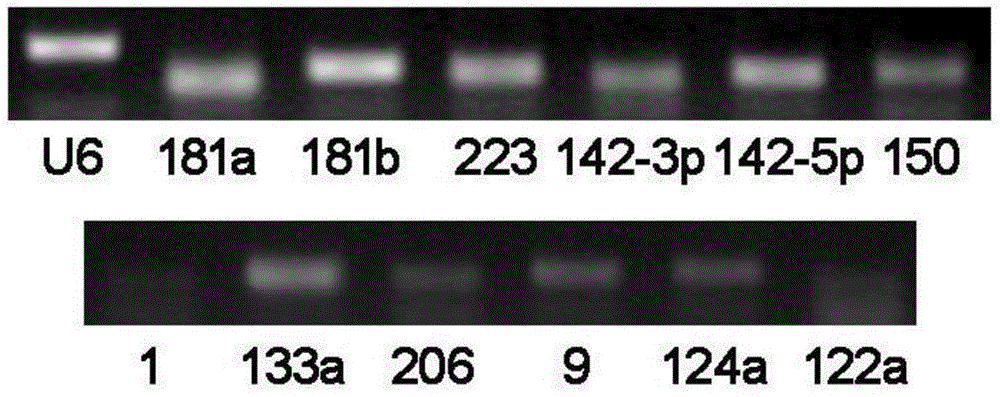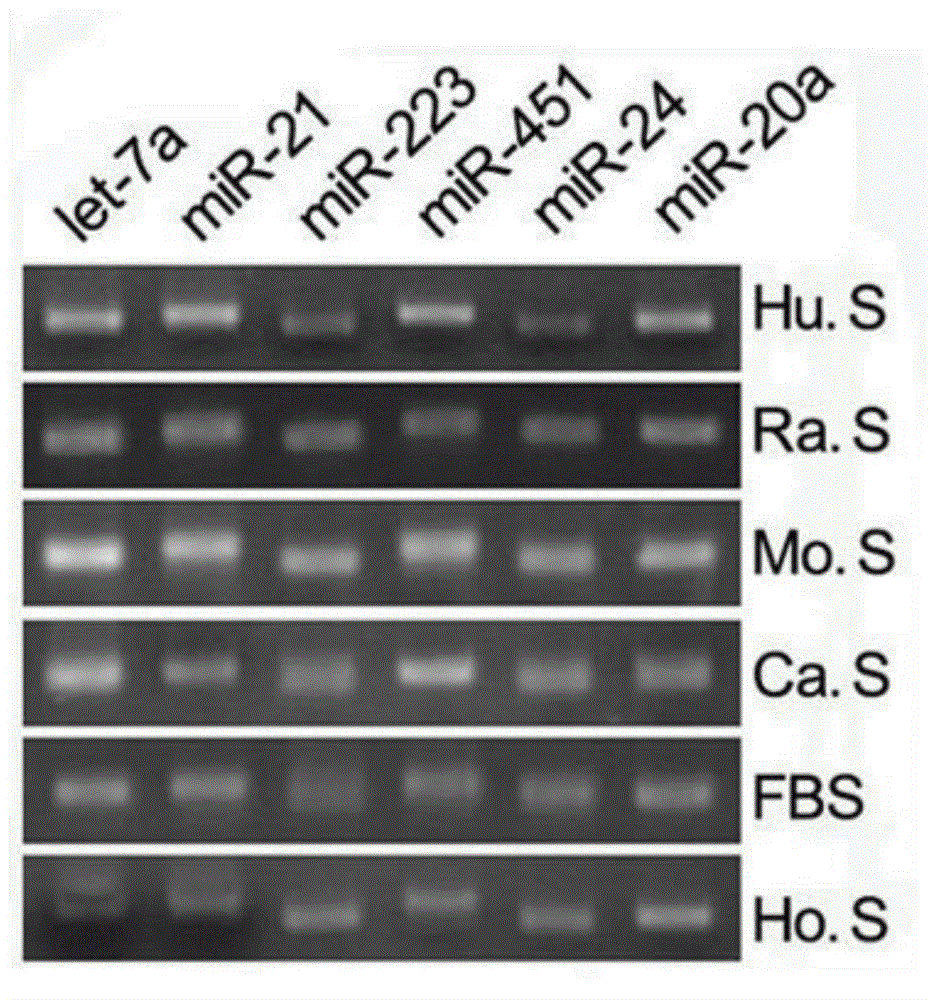Non-small cell lung cancer marker as well as detection method and application thereof
A technology for non-small cell lung cancer and detection methods, which is applied in biochemical equipment and methods, microbial determination/inspection, DNA/RNA fragments, etc. question
- Summary
- Abstract
- Description
- Claims
- Application Information
AI Technical Summary
Problems solved by technology
Method used
Image
Examples
Embodiment 1
[0090] The RT-PCR experiment of microRNA in embodiment 1 serum / plasma
[0091] Using RT-PCR technology to discover and prove that various microRNAs exist stably in human and animal serum / plasma, and their expression is quite abundant. The specific steps are:
[0092] (1) Collect serum / plasma from mice, rats, normal people and certain patients;
[0093] (2) Preparation of cDNA samples. There are two schemes for this operation. One scheme is to directly perform reverse transcription reaction on 10 μl serum / plasma, and the other is to use Trizol reagent (Invitrogen) to extract serum / plasma total RNA first (10ml serum / plasma can usually enrich about 10 μg left and right RNA), and then cDNA was obtained by RNA reverse transcription reaction. The reverse transcription reaction system included 4 μl 5×AMV buffer, 2 μl 10 mM each dNTP mixture (Takara), 0.5 μl RNase Inhibitor (Takara), 2 μl AMV (Takara) and 1.5 μl gene-specific reverse primer mix. The reaction steps are incubation...
Embodiment 2
[0097] The real-time PCR experiment of microRNA in embodiment 2 serum / plasma
[0098] In order to study the specific changes of serum / plasma microRNA in the course of non-small cell lung cancer, the quantitative PCR experiment of serum / plasma microRNA was carried out. The experimental principle and experimental steps of quantitative PCR are the same as RT-PCR, the only difference is that the fluorescent dye EVA GREEN is added during PCR. The instrument used was ABI Prism7300 fluorescent quantitative PCR instrument, and the reaction conditions were 95°C, 5 minutes for 1 cycle → 95°C, 15 seconds, 60°C, 1 minute for 40 cycles. The data processing method is the ΔΔCT method, and CT is set as the cycle number when the reaction reaches the threshold value, then the expression level of each microRNA relative to the standard internal reference can be expressed by equation 2-ΔCT, where ΔCT=CT sample-CT internal reference. The patient's serum / plasma sample and normal human serum / plasm...
Embodiment 3
[0100] Embodiment 3 is used for diagnosing the serum / plasma microRNA chip of non-small cell lung cancer
[0101] The chip operation process is as follows:
[0102] (1) Extract total RNA from serum / plasma, and detect the quality of total RNA by formaldehyde denaturing gel electrophoresis;
[0103] (2) Isolation of microRNA: Take 50-100 μg of total RNA and use Ambion's miRNA Isolation Kit (Cat#.1560) to isolate microRNA;
[0104] (3) Fluorescent labeling of microRNA samples: use T4RNA ligase labeling method for fluorescent labeling, then precipitate with absolute ethanol, dry and use for chip hybridization;
[0105] (4) Hybridization and washing: Dissolve RNA in 16 μL of hybridization solution (15% formamide; 0.2% SDS; 3×SSC; 50×Denhardt’s solution), and hybridize overnight at 42°C. After the hybridization, wash in a liquid containing 0.2% SDS and 2×SSC at about 42°C for 4 minutes, then wash in a 0.2×SSC liquid for 4 minutes at room temperature, and the slides can be used fo...
PUM
 Login to View More
Login to View More Abstract
Description
Claims
Application Information
 Login to View More
Login to View More - R&D Engineer
- R&D Manager
- IP Professional
- Industry Leading Data Capabilities
- Powerful AI technology
- Patent DNA Extraction
Browse by: Latest US Patents, China's latest patents, Technical Efficacy Thesaurus, Application Domain, Technology Topic, Popular Technical Reports.
© 2024 PatSnap. All rights reserved.Legal|Privacy policy|Modern Slavery Act Transparency Statement|Sitemap|About US| Contact US: help@patsnap.com










